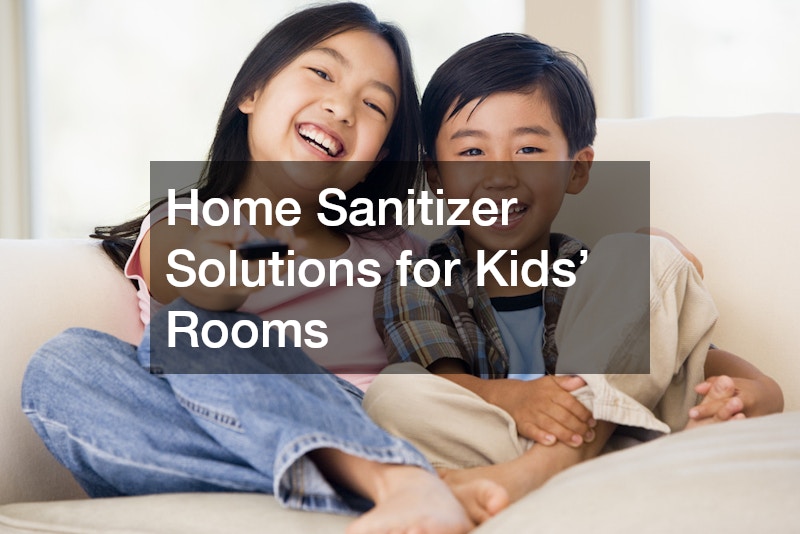Understanding the importance of maintaining a sanitized home environment is crucial for promoting health and well-being. By reducing germs and contaminants, we contribute to a healthier living space, minimizing the risks associated with various infections and allergic reactions. The home is often regarded as a sanctuary—a place where we find solace, whether to relax or spend time with family. It should always be a place of comfort, free from unhappiness or struggle. This guide will explore key factors to help you make informed decisions about the home sanitizer solutions that best suit your household needs.
1. What are Home Sanitizer Solutions and Why are They Important?

Home sanitizer solutions encompass a range of cleaning agents and methods specifically designed to eliminate germs, bacteria, and viruses that reside on household surfaces. These solutions include commercial cleaning products, as well as DIY formulations made from natural ingredients. They are essential tools in reducing the risk of illness and maintaining overall cleanliness.
1.1 Definition and Types of Home Sanitizer Solutions
A home sanitizer solution can be defined as any substance or method used to reduce pathogens on surfaces within the household. This includes alcohol-based sprays, disinfectant wipes, natural cleansers, and more. Each type of solution works differently; for example, alcohol-based products typically kill viruses and bacteria by denaturing proteins.
1.2 Importance of Using Home Sanitizer Solutions
The use of home sanitizer solutions is critical for maintaining a sanitized environment that protects against diseases. By effectively eliminating harmful microorganisms, these solutions help prevent the spread of contagious diseases. Utilizing them reduces overall exposure to allergens, creating a healthier indoor environment.
1.3 Overview of Home Sanitizer Efficacy
The efficacy of home sanitizer solutions is often measured by their ability to decrease microbial presence on surfaces. Testing by a roof cleaning company and other commercial cleaning services often demonstrates the effectiveness of different solutions under varied conditions. For optimal results, it is essential to follow usage guidelines and apply appropriate quantities on the intended surfaces.
2. How to Choose the Right Sanitizer Solution for Each Room?
Selecting the appropriate home sanitizer solution for each room involves assessing specific cleaning requirements and considerations. Different areas of the home have unique challenges, from cooking in the kitchen to mold management in the bathroom. Thus, tailoring the choice of sanitizer to each room’s needs is crucial.
2.1 Evaluating the Cleaning Needs of Each Room
Every room in the house presents different cleaning challenges that require specific home sanitizer solutions. For example, kitchens demand food-safe sanitization, while bathrooms often battle moisture-induced issues like mold. Therefore, understanding the primary problems each room faces helps in selecting suitable cleaning agents.
2.2 Selecting Sanitizers Based on Ingredients
The key to choosing effective sanitizer solutions lies in understanding their ingredients. Active components such as ethanol, hydrogen peroxide, and quaternary ammonium are common in powerful disinfectants. However, for those seeking natural alternatives, plant-based substances can offer eco-friendly options without harsh chemicals.
2.3 Safety Considerations in Choice of Sanitizers
In choosing home sanitizer solutions, safety concerns play a pivotal role. Particularly in households with children or pets, it is vital to opt for non-toxic formulations. Ensuring proper ventilation and observing recommended usage instructions further mitigates risks associated with chemical exposure within living spaces.
3. What are the Best Home Sanitizer Solutions for Kitchens?
The kitchen, being a focal point for food preparation, requires specific home sanitizer solutions that ensure maximum hygiene while being safe around food. Grease traps and high-contact surfaces present unique cleaning challenges, which are best addressed by targeted sanitizers.
3.1 Ideal Sanitizers for Food Preparation Areas
Choosing the right sanitizer for food preparation areas involves utilizing products that are effective yet safe for surfaces that encounter food. Germicidal sprays and wipes containing food-safe disinfectants provide an ideal balance, eliminating pollutants without compromising food safety standards.
3.2 Effective Solutions for Kitchen Appliances
Kitchen appliances require regular cleaning with solutions that can remove grime and grease. Vinegar-based cleaners, commercial stainless steel sprays, and degreasers specifically designed for kitchen appliances are excellent choices. These solutions reduce the build-up and prevent residue from affecting appliance performance.
3.3 Addressing Grease and Stain Removal
One of the most common kitchen issues involves handling grease and stains. Specialized home sanitizer solutions are available with reinforced cleaning abilities specifically for tackling tough grease and persevering in stain removal. Coupled with grease trap cleaning services, these solutions ensure a kitchen remains spotlessly sanitized.
4. How to Sanitize Bathrooms Effectively?

Bathrooms are hotspots for moisture accumulation and bacterial growth, making sanitation a critical aspect. Comprehensive sanitizing practices not only improve hygiene but also address aesthetic concerns like mold and mildew, achieved through effective use of home sanitizer solutions.
4.1 Recommended Sanitizers for Bathroom Surfaces
For bathroom surfaces like countertops, sinks, and tiles, it is important to employ home sanitizer solutions capable of eliminating harmful microbes. Bleach-based disinfectants serve well for these purposes, as they effectively target bacteria and fungi prevalent in wet environments.
4.2 Solutions for Shower and Toilet Areas
Maintaining a clean shower and toilet requires particular attention to solutions that prevent germs common in such areas. Local septic cleaners, bleach-based toilet wipes, and mildew-specific sprays ensure these high-usage areas remain pristine while avoiding odors commonly associated with bathrooms.
4.3 Managing Mold and Mildew with Sanitizers
Mold and mildew constitute common challenges within bathroom environments. Powerful solutions, inclusive of industrial-grade cleaners and mold preventative sprays, are often necessary. When dealing with major infestations, professional interventions such as pressure washing may be warranted to achieve deeper cleanliness.
5. What Solutions Work Best in Living Rooms?
Living rooms serve as central communal areas, necessitating home sanitizer solutions that address a diversity of sanitization needs. These rooms should be kept comfortable and clean, with attention to upholstery, electronics, and overall odor maintenance.
5.1 Choosing Sanitizers for Upholstery and Fabrics
Upholstery and fabrics in the living room require gentle sanitizers that will not damage materials while effectively sanitizing. Enzyme-based cleaners offer such a balance, safely breaking down messes while preserving the color and texture of fabrics and upholstery.
5.2 Keeping Electronics Clean and Sanitized
As electronics are integral in living rooms, maintaining their cleanliness and functionality entails using specific solutions. Isopropyl alcohol wipes are excellent for screens and remote controls, providing sanitation without damaging sensitive components.
5.3 Handling Odor Control in Living Spaces
Odor control in living rooms is crucial for maintaining a welcoming ambiance. Environmental cleanup methodologies, combined with air fresheners and odor-eliminating sprays, ensure that living spaces remain fragrant and free of unpleasant smells.
6. Are There Specific Solutions for Bedrooms?
Bedrooms should be tranquil sanctuaries where cleanliness plays a vital role in ensuring comfort and health. Home sanitizer solutions appropriate for bedroom settings focus on keeping beddings fresh, improving air quality, and minimizing bacteria.
6.1 Solutions Suitable for Bedding and Mattresses
Maintaining a hygienic sleep environment involves utilizing bedroom-specific home sanitizer solutions, such as fabric sprays containing antimicrobial formulas. These sprays help maintain bedding freshness while eliminating dust mites and allergens, ensuring restful sleep.
6.2 Air Quality Improvement and Sanitization
Enhancing air quality in bedrooms requires consideration of solutions that purify the surroundings. Air purifiers, when combined with sanitizing room sprays, notably improve indoor air quality by capturing potentially harmful particles and ensuring a clean breathing environment.
6.3 Bacteria and Allergen Reduction Strategies
Effective bedroom sanitization includes strategies that reduce bacteria and allergens, such as using hypoallergenic detergents and employing regular vacuuming with heap filters. Additional measures like drain cleaners for adjacent bathrooms help maintain comprehensive cleanliness throughout living areas.
7. Home Sanitizer Solutions for Kids’ Rooms

Kids’ rooms demand meticulous care with home sanitizer solutions that ensure safety without compromising on effectiveness. Special attention is necessary for toys, floors, and fabrics that children frequently engage with.
7.1 Child-Safe Sanitization Products
The primary consideration for kids’ rooms involves opting for child-safe sanitization products. These products prioritize non-toxic ingredients, ensuring a secure environment while effectively neutralizing pathogens on surfaces.
7.2 Maintaining Toy Hygiene
Toys in children’s rooms are surfaces that require routine sanitization. Approved home sanitizer solutions include diluted bleach solutions or toy-specific disinfectant wipes, which help in effectively reducing germs without leaving harmful residues.
7.3 Floors and Rug Sanitization Techniques
Hygiene beneath playful feet necessitates focusing on floor and rug sanitization techniques. Steam cleaning or using gentle yet effective carpet cleaners ensures that floors remain free from harmful bacteria, contributing to an overall safe play area for kids.
8. How to Sanitize Home Offices?
The rise of remote work has increased the importance of maintaining sanitized home offices. These workspaces require home sanitizer solutions that are tailored to office equipment and documents, ensuring a productive and clean environment.
8.1 Cleaning Electronic Devices and Desktops
Keyboards, screens, and desktops demand specific sanitizing techniques to preserve equipment longevity. Electronics-specific cleaners play a key role, removing dust, oils, and germs without causing damage to sensitive hardware.
8.2 Paper and Filing System Maintenance
Maintaining a tidy filing system involves using solutions that resist paper degradation while eliminating germs. Commercial window cleaners sometimes double as suitable wipes, offering a delicate touch needed for maintaining document integrity.
8.3 Solutions for Multi-Purpose Office Rooms
In multi-purpose office rooms doubling as guest spaces, versatile cleaning solutions are necessary. Combining household disinfectants with specialized office equipment cleaners ensures comprehensive sanitization throughout the multifunctional room.
9. Best Practices for Sanitizing Basements and Garages
Basements and garages are susceptible to issues that require targeted home sanitizer solutions. Addressing moisture and invalidating pathogens preserves the longevity and safety of these additional household spaces.
9.1 Addressing Moisture and Humidity Issues
Moisture control in basements is best achieved by employing dehumidifiers coupled with mildew-resistant sprays. Professional local roof cleaning services may further assist in mitigating structural moisture ingress around basements.
9.2 Solutions for Tools and Equipment
In garages, tools and equipment necessitate oil and grease removal through targeted home improvement contractors‘ recommended cleaning agents. Sanitizer solutions that specialize in de-greasing ensure both the functionality and hygiene of these essential items.
9.3 Storing Sanitizers Safely in These Areas
Proper storage of sanitizer solutions in basements and garages demands consideration of stability and accessibility. Labeling, proper sealing, and storing chemicals out of reach—or within cabinets—are best practices advised for any household sanitization regime.
10. Eco-Friendly Home Sanitizer Solutions

Eco-friendly home sanitizer solutions have gained popularity as awareness regarding environmental impacts increases. These sustainable options mitigate chemical impact while ensuring effective sanitation in homes.
10.1 Understanding Eco-Friendly Sanitizers
Eco-friendly sanitizers utilize ingredients derived from natural sources, thereby reducing chemical footprint. Plant-based enzymes, citrus extracts, and essential oils exemplify common ingredients offering germicidal properties in these greener options. Eco-friendly home sanitizer solutions are biodegradable, non-toxic, and often free from artificial fragrances or dyes, making them a safer choice for households with children or pets. By opting for eco-conscious cleaning products, you not only create a healthier living space but also contribute to sustainable practices that benefit the environment in the long run.
10.2 DIY Natural Sanitizer Recipes
For those seeking homemade alternatives, common ingredients like rubbing alcohol, vinegar, and essential oils can be combined to create powerful, non-toxic sanitizers. For example, a basic DIY sanitizer recipe involves mixing 2/3 cup of rubbing alcohol, 1/3 cup of water, and a few drops of essential oils like lavender or tea tree oil for added antibacterial properties. Not only do these homemade solutions effectively kill germs, but they are free from harsh chemicals, making them safer for your family and the environment. With a little effort, you can easily customize these recipes to suit your cleaning needs.
10.3 Benefits and Limitations of Eco-Friendly Options
While eco-friendly sanitizer options mitigate health risks associated with chemical exposure and support environmental stewardship, certain limitations such as reduced shelf life or lower potency may arise. Balancing benefits against desired efficacy is crucial when opting for these alternatives.
Home sanitizer solutions are indispensable resources in maintaining household health and hygiene. This extensive guide has explored diverse options suited to different rooms within the home, from kitchens to basements, ensuring that strategic cleaning protocols are implemented effectively.
By adopting suitable home sanitizer solutions, we uphold an environment that promotes health, well-being, and comfort for all household members. Let us embrace safe and effective practices, thereby fostering spaces that prioritize cleanliness and sustainability through informed choices.

